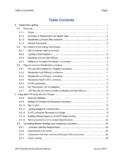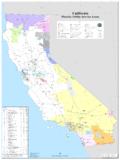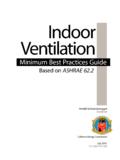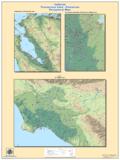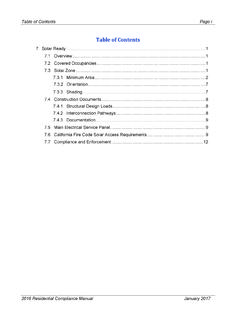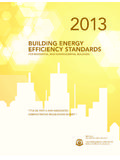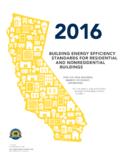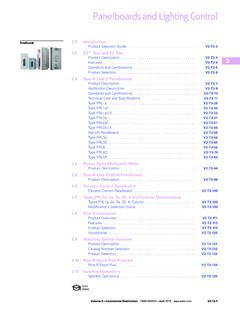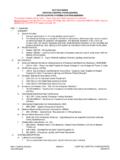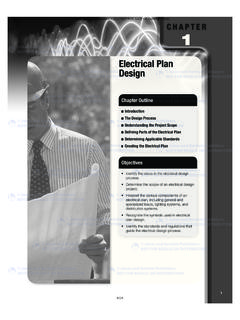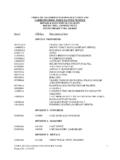Transcription of Table of Contents - California Energy Commission
1 Table Contents Page i Table of Contents 8. Electrical Power Distribution .. 1 1 Scope .. 1 Summary of Requirements .. 2 Service Metering .. 3 What is the Electrical Service ? .. 3 Buildings with Multiple Services .. 4 Practical Considerations .. 4 Summary .. 7 Disaggregation of Electrical Circuits .. 8 Disaggregation increases as loads get larger .. 9 Voltage Drop .. 14 Purpose of this Requirement .. 14 Applying Voltage Drop Calculations .. 15 Calculations .. 15 Suggested Calculation Approach .. 16 Circuit Controls for 120-Volt 24 Practical Considerations .. 25 Demand response Application Notes .. 26 Energy Management control System (EMCS) .. 27 Additions and Alterations .. 28 Electrical Power Distribution Systems Compliance Documents.
2 29 Overview .. 29 Submitting Compliance Documentation .. 29 Varying Number of Rows per Document .. 29 Compliance Documentation Numbering .. 29 Certificate of Compliance Documents .. 30 Instructions for Completing Electrical Power Distribution Systems Certificate of Compliance .. 30 Section A: Electrical Service Metering .. 32 Section B: Disaggregation of Electrical Circuits .. 32 Section C: Voltage Drop .. 33 2013 Nonresidential Compliance Manual January 2014 Table Contents Page ii Section D: Circuit Controls for 120-Volt Receptacles .. 33 2013 Nonresidential Compliance Manual January 2014 Electrical Power Distribution Overview Page 8-1 8. Electrical Power Distribution This chapter covers Section , which covers Energy efficiency requirements for electrical systems.
3 It is addressed primarily to electrical engineers and to enforcement agency personnel responsible for electrical plan checking and inspection. This chapter is new to the 2013 version of the Nonresidential Compliance Manual. It been developed because the Standards themselves have been restructured to create a new section (Section ) for electrical power system requirements, distinct from lighting control system requirements (Sections through ). In deliberations concerning the 2013 standard, the Commission determined that important emerging issues of circuit metering and disaggregation, plug load (receptacle) controls, demand response systems, and Energy management and control systems (EMCS) were cost effective provisions that would either save Energy directly, or serve the invaluable purpose of allowing cost effective Energy use monitoring for management purposes.
4 In addition, the Standard was changed to make voltage drop limits mandatory that had previously been recommended but not required by the California Electrical Code (Title 24 Part 3). Overview All the requirements in Section are mandatory, and therefore are not included in the Energy budget for the whole building performance method. Scope The requirements for electrical power distribution systems apply to all non-residential buildings. The intention is to save Energy and to allow future systems for power use monitoring and control to be added when expected changes in the marketplace occur. A. New Construction and Additions This Section applies to all new structures, and to some additions and alterations to existing structures. For additions to existing structures, electrical circuits and Energy Management control Systems (EMCSs) must in general meet the requirements of Section if they: Serve a lighting system Serve an altered space-conditioning system or water heating system Serve an addition to an outdoor lighting system See Section (a) of the Code for a list of exceptions B.
5 Existing Construction For alterations to existing spaces, electrical circuits and EMCSs that have been altered must in general meet the requirements of Section only if: Serve lighting, space conditioning or water heating systems Are newly installed components of an existing system 2013 Nonresidential Compliance Manual January 2014 Electrical Power Distribution Overview Page 8-2 See Section (Additions and Alterations), for a list of exceptions. However, the requirements of Section are invoked when any of the following occur: Additional feeder(s), panelboard(s), major load(s), and/or motor control center(s) are added. A new service and/or main switchboard or panelboard is installed. A building is re-purposed and new panelboards and feeders are installed. C. Acceptance Testing, Commissioning, and Installation Certificates The requirements of Section are not subject to acceptance testing or commissioning.
6 Summary of Requirements The requirements of Section are organized as follows: A. Service Metering Each electrical service shall have metering that will allow the building Owner to get useful information for managing the use of electrical power. The requirements increase as the size of the service increases. For smaller services, the building owner must be able to manually read the Energy use (kWh) meter and to reset the readout to allow for period measurements, without of course affecting revenue measurements. As service size increases, the meter must also allow for demand measurements so that the building owner or operator can gain a better understanding of how and when the building uses electrical power. If the building is equipped with an Energy Management and control System (EMCS) that provides these measurements, then the manual system is not required.
7 B. Disaggregation of Electrical Circuits Above a minimum threshold that varies by load type, electrical power systems must be designed and built such that the total load of specific building load types can be measured. For instance, lighting loads must be able to be measured independently of HVAC loads. The intent is to have a single feeder or breaker with each type of load (such as lighting) on it, such that a meter could be placed on the feeder to report Energy use by that load type. Note that this is a wiring requirement only, and the providing of meters is optional. C. Voltage Drop This section makes the National Electrical Code/ California Electrical Code suggestion of voltage regulation mandatory, limiting branch circuit voltage drop to 3% at design load and to 2% in feeders at design load. D. Circuit Controls for 120-Volt Receptacles This section adds minimum requirements for switching of 120-volt receptacles in non-residential applications.
8 The primary reason is to permit simple control of furniture mounted task lights and other plug loads. There are a number of exceptions and exemptions to this requirement as not all receptacles require control . E. Demand Response Controls and Equipment 2013 Nonresidential Compliance Manual January 2014 Electrical Power Distribution Service Metering Page 8-3 Section (f) requires nonresidential buildings over 10,000 sf to have a demand responsive lighting system. The provisions of new Section (e) require that demand responsive loads be equipped with controls that can receive at least one demand response signal and respond. F. Energy Management control System (EMCS) For buildings employing Energy Management control Systems, some of the above requirements are modified provided that the EMCS provides them. Service Metering Projects are required to provide an electric meter that permits the building owner or manager to read the instantaneous power in kilowatts being used by the building, and to be able to reset and measure Energy use in kilowatt-hours over a period of his own choosing.
9 If this is possible from the utility company s revenue service meter, then an additional meter does not need to be provided. For larger buildings and electrical systems (greater than 250 kVA, which is 700 amps at 120/208 volts three phase and over 1000 amps at 120/240 volts single phase), the meter must also record the historical peak demand in kilowatts. For much larger systems (greater than 1000 kVA, which is over 2700 amps at 120/208 volts three phase and over 4000 amps at 120/240 volts single phase, the meter must also be able to report the kWh for a fixed rate period. Table (see page 13 below) repeats these requirements in Table form. What is the Electrical Service ? The word service originates in Article 110 of Title 24 Part 3, the California Electrical Code. The Code intends that the service is where electric power enters a building or other structure.)
10 For safety and security, there are number of specific requirements for the service, such as where they must be located, how many disconnecting devices may be used, and how they must be labeled, as described in Article 230 of the Code. The Electrical Code defines service as, The conductors and equipment for delivering electric Energy from the serving utility to the wiring system of the premises served . To many people, this indicates that the service is where a utility company provides power to the building or structure. In fact, most buildings1 are served directly by the electric utility company, and the service includes a revenue meter. The requirements of Section (A) refer to this service and to this meter. But not all buildings are connected directly to the utility company and not all services have revenue-measuring meters. For example, a college campus might purchase bulk power from an electric utility company, to save Energy costs.
